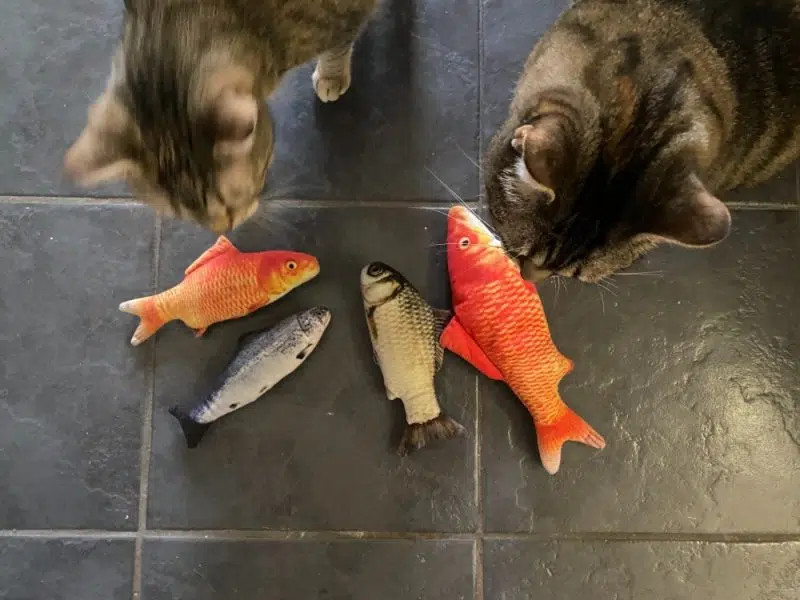Being a cat parent is full of joys – the purrs, the cuddles, and the playful pounces. However, our feline friends also have a knack for getting into mischief, sometimes with their stomachs! Unlike dogs, cats are often considered more discerning eaters, but as a veterinarian, I can tell you they still manage to swallow things they really shouldn’t. From sparkly tinsel to squishy toys, their curiosity can sometimes outweigh their common sense.
Just like the time my friend ended up in the ER after a Lego-related experiment gone wrong, cats can also surprise us with their questionable dietary choices. In my practice, I’ve encountered cats who’ve dined on plastic carrots, doll heads, straw pieces, and even pinecones! It’s always an adventure guessing what they’ll try to eat next. To help keep your feline friend safe and avoid an emergency vet visit, let’s talk about some common household items that frequently cause problems for curious kitties. These are items my own cats, Pancake and Tiller, are strictly forbidden from getting near!
Top 6 Items Cats Inappropriately Snack On (And Why It’s a Problem!)
1. Thread (and Sewing Kits!)
Thread, especially when attached to a needle, is a notorious culprit in feline foreign body cases. It might seem harmless, but thread can become incredibly dangerous once swallowed. It can easily wrap around a cat’s tongue, anchoring itself and causing severe complications. As the intestines attempt to process the thread, it can bunch up, acting like a saw and slicing through the intestinal walls. This can lead to serious infections and inflammation in the abdominal cavity as intestinal contents leak out. I once treated a cat who had been suffering for weeks after eating thread, enduring constant pain from the thread lodged on her tongue and the damage to her intestines. Trust me, it’s something you want to avoid!
2. Fishing Lures: Not Just for Fish
With their enticing feathers and shiny hooks, fishing lures can appear irresistible to a playful cat. Unfortunately, many cats mistake them for toys, leading to accidental hook ingestion. I’ve sadly seen too many cases of cats with fishhooks lodged in their mouths, tongues, or cheeks. These require careful (and often sedated) removal to prevent further injury.
3. Human Toys: Size Matters!
Small, squishy human toys like bouncy balls are often feline favorites, but their size makes them perfectly designed to get stuck in a cat’s small intestine. These obstructions can require surgery to remove and can cause significant digestive distress. Stick to cat-specific toys that are designed with safety in mind.
 Pancake observing Tiller's fishing lure with a confused expression
Pancake observing Tiller's fishing lure with a confused expression
Well-designed cat toys are a much safer option to keep your feline entertained without the risk of intestinal blockages from small human toys.
4. Foam: From Earplugs to Flip-Flops
Some cats seem to have a strange fascination with foam. I’ve treated patients who have chewed on everything from earplugs to pieces of flip-flops. Perhaps it’s the texture, or maybe these items pick up interesting scents from their environment that make them appealing to curious cats. Regardless of the reason, foam ingestion is not ideal and can cause digestive upset or blockages depending on the amount consumed.
5. Hair Ties: A Tangled Trouble
Hair ties are another common household item that cats love to bat around and chase. However, their small size and elastic nature make them easily ingested. As I’ve discussed before, hair ties can cause intestinal blockages and require veterinary intervention.
6. Christmas Tinsel: Holiday Hazard
That sparkly, dangling Christmas tinsel might seem like the perfect festive toy for your cat, but it’s a significant holiday hazard. Tinsel is easily ingested and, like thread, can cause linear foreign bodies in the intestines, leading to serious complications. Keep the tinsel out of paw’s reach during the holiday season!
The holidays, with their abundance of new and unusual items, are especially critical times to be extra vigilant about what your cat might find tempting to play with and potentially ingest.
My Cat Ate Something Inappropriate! Now What?
While this list covers some of the most common culprits, cats can and do ingest a wide variety of foreign objects. The key takeaway is to be aware of these common hazards and proactively keep them away from your curious cat.
So, what should you do if your cat manages to eat something from this list, or anything else you suspect is inappropriate? The answer, in almost every case, is: contact your veterinarian immediately!
For items like thread, a vet will need to perform an exam, often under anesthesia, to check for thread wrapped around the tongue. Fishhooks also typically require sedation for safe and effective removal. Even if you suspect a small item might pass on its own, a veterinary check-up is crucial. Your vet can help you create a plan to monitor your cat and address any potential complications.
Prevention is always the best medicine. Avoiding these scenarios altogether is far less stressful (and costly!) than dealing with the aftermath of foreign body ingestion. In the worst-case scenario, surgery might be necessary to remove the ingested item. (Speaking of unexpected vet bills, have you read my article on the importance of pet insurance for cats?)
Ultimately, we cherish our feline companions. By being mindful of potential hazards and keeping dangerous items out of reach, we can help ensure their safety and well-being, and avoid saying, “Please don’t eat that!” a little too late.
This article is part of Dr. Lauren, Pancake, and Tiller’s ongoing series dedicated to feline health and well-being.
